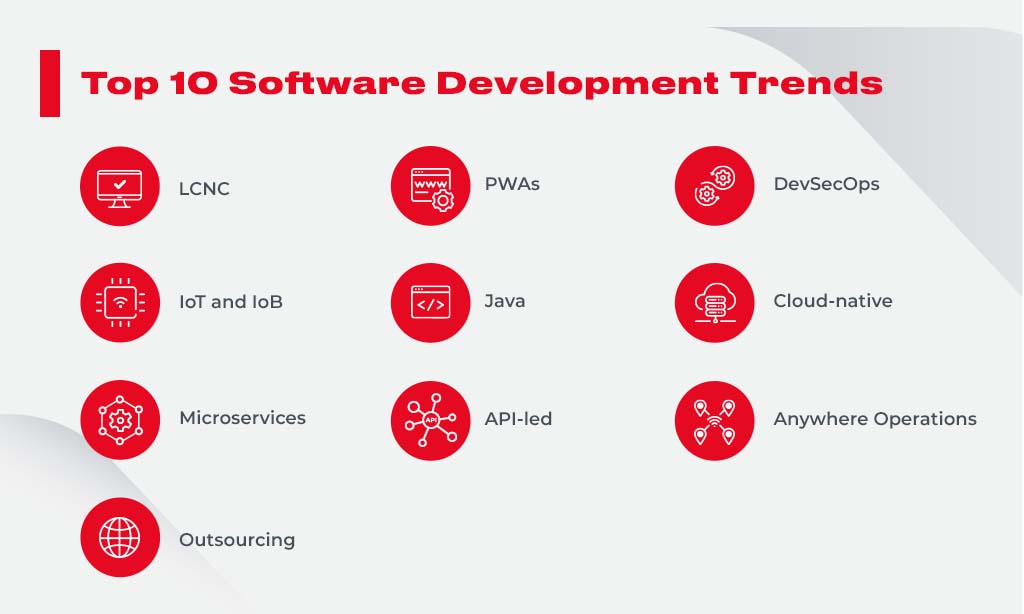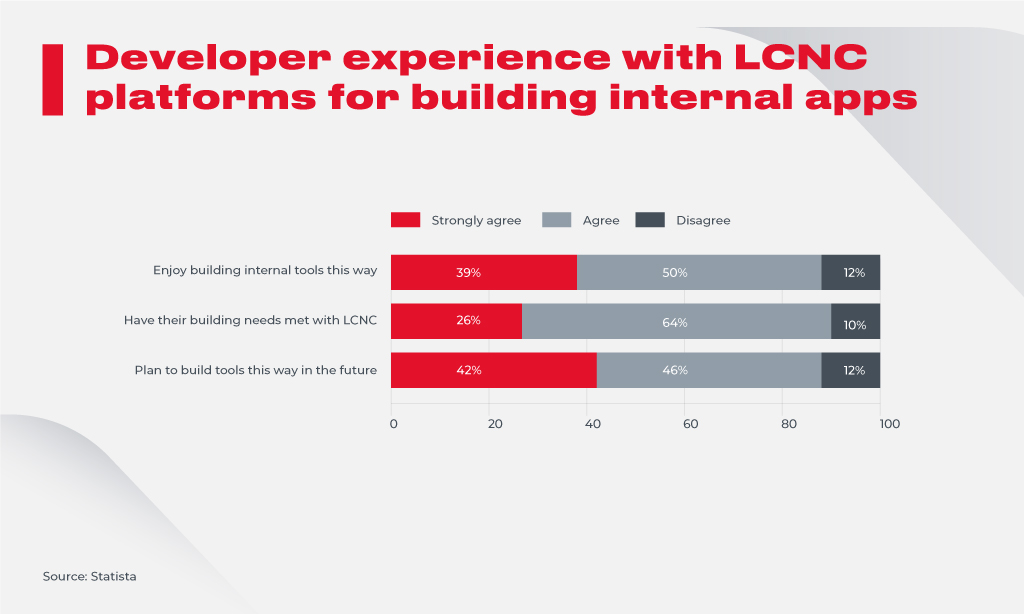Top 10 Software Development Trends To Add Massive Value To Your Business
An unstoppable digital transformation has already affected hundreds of spheres, from supply chain management, e-commerce, public sector, to fintech, healthcare, and retail. Companies worldwide strive to embrace the latest tech to remain competitive, increase customer loyalty, and accelerate revenue streams.
The business world is transforming in front of our very eyes, due to daily upgrades of what automation and software development can do. Amidst this change, a true entrepreneur understands how crucial it is to keep their hands on the pulse of tech breakthroughs. After all, if you do not deliver a product that is fresh and reflective of where the industry’s headed – someone else will.
The knowledge of new technological possibilities is a useful element of your company’s toolbox and a valuable weapon in the competitive market. So, let us sharpen that blade with a top ten of software development trends for the nearest future.

Low-code no-code movement
The more technologies appear in the era of digitalization, the bigger a skill gap becomes. There are many techs to adopt but there is an urgent need for experts in a certain field. Many organizations cannot overcome barriers in the way of implementation due to the lack of software developers.
To fill the voids in software development, there is a solution known as LCNC (Low-Code No-Code). Low Code No Code (LCNC) development refers to a visual environment, where citizen developers (people with low or no coding skills) can drag and drop ready-to-use apps components, combine them, and integrate them to create the desired program.
The idea is that everyone can participate in software creation, with minimal or no regard for programming knowledge. And such an approach appears to be working: a 2021 survey revealed that LCNC was a great source of motivation for new developers, and had high rates of “would use again” responses, filling the vacancies in the industry.

Microservice architecture
Microservice architecture (microservices) is the style to structure an application as a set of services that are: easy manageable and testable, loosely coupled, can be independently deployed, organized according to business capabilities, and can be handled by small teams.
As the businesses keep on shifting towards the cloud, the microservice architecture will be more prevalent:

The internet of things and internet of behavior
IoT is a network of physical devices and objects with sensors that transmit collected data over the internet using APIs (application programming interfaces). IoT works thanks to a combined interaction of multiple technologies like Big Data, AI, radio-frequency identification (RFID), and APIs.
Being a buzzword among software development trends, IoT has firmly taken its place:
- Modern factories become more automated, thanks to IoT.
- In the supply chain, using connected devices with sensors allows employees to track the journey of the goods from manufacturer to retailer.
- Advanced security of homes with IoT sensors, cameras, and analytics allows residents to be sure their houses are well protected.
- Self-driving cars and wearables are everyday realities that are here to stay.
Now, it is time for the next logical step, which is IoB, or the Internet of Behavior. This new technology turns to data analysis to predict the behavioral patterns of software users, in order to make their experiences better for them, and more profitable for the company, in advance. This promising technology is expected to touch 40% of the population by 2023, so keep an eye out.
Outsourcing
Business networks become more and more sophisticated, this is why there is a need to leverage on-premise proficiency in the best way. Therefore, while trying to focus the business on the core competencies, company executives entrust the secondary tasks to third parties that have expertise there. This trend realization propels the popularity of IT outsourcing.
A recent 2018-2019 survey by IT Spending and Staffing Benchmarks revealed that large organizations spent more on software outsourcing, showing growth from 6.3% to 8.7%, whereas midsize companies also dramatically increased their investments – from 4.7% to 6.5%.
Outsourcing software development allows enterprises to focus on their long-term prospects, reduce operating costs, and provide consumers with a flawless product. Innovecs is a reliable partner if you decide to outsource some of your development tasks or even an entire project.
Progressive web apps
A progressive web app is a compromise between native and web applications. Stationed online, it has push notifications and can download onto your device. PWA is created through the use of four specific technologies.

The targets of PWA are:
- Reliable – the application is loaded and displayed immediately, regardless of the status and quality of the network connection.
- Fast – data exchange over the network is fast, while the UI is smooth and responsive.
- Engaging – make the users’ experience with the application comfortable and pleasant, encouraging them to leverage it again and again.
JavaScript
The title of the most popular programming language never stays consistent. While several years ago Python reigned supreme, today JavaScript is considered the most widespread.

JavaScript is frequently chosen for its versatility, simplicity, and modernity. Whether you are creating a PC game, a mobile application, or a mere additional feature for a website, JavaScript can do it all. This programming language has been enjoying the favor of developers for many years now, and even if it does not place at the very top of the “most popular” list in 2022, rest assured – JavaScript is not going anywhere in the nearest years.
Api-led integrations
Recent years have significantly changed the public’s relationship with essential resources, and this shift of mentality did not bypass technology. It is clear that software development of the future will be all about trimming the unnecessary fat off of business operations. In 2021, The State of SaaS Sprawl revealed that only 45% of a company’s SaaS apps are being used on a regular basis. Add the fact that 56% of all these apps are either shadow IT or regulated outside of IT altogether, and the image you get is of millions of businesses simply doing too much with their Saas distribution.
Hybrid integrations are gaining momentum as a possible alternative, connecting data and apps via APIs to create shortcuts and maximize visibility. For business owners, API-led integrations translate to making data-driven decisions that stem from transparent, and thus fully controlled, processes. During the pandemic, the ability to ensure your inner kitchen is frugal became a factor that can make or break a company. With that in mind, we will likely see more API-led integrations coming around.
DevSecOps
Cybersecurity has become such an inalienable part of software development, that reaching a point of agile protection was only a matter of time. Now, DevSecOps takes center stage, with security precautions at every single step of the development cycle.

This update was a long time coming. According to a 2021 ThycoticCentrify report, “57% of organizations suffered security incidents related to exposed secrets in DevOps.” DevSecOps is quite literal in its interpretation, meaning DevOps with security measures inside. Every step of software development has to conclude with a thorough inspection and validation of cyber protection, to put up more wards against attacks on any segment of the program.
Cloud-native platforms
In 2022, traditional architectures may prove a bit too rigid for the most modern of applications. Cloud-native development platforms are the newest choice to solve problems of scalability and heaviness for new ambitious startups.
The Cloud Native Computing Foundation (CNCF) defines cloud-native technologies as ones that “empower organizations to build and run scalable applications in modern, dynamic environments such as public, private, and hybrid clouds”. Look no further than Netflix and Spotify to see the merits of cloud storage for millions of hefty files, and access to any number of users all over the world.
Cloud platforms are resilient, observable, and relatively easy to manage. All of this makes them a perfect response to the main needs of the software development industry today and ensures that we will see more cloud-native platforms in the years to come.
Anywhere operations
Last, but not least, is the trend most accelerated by the pandemic lifestyle. Anywhere operations is a model that prioritizes remote interactions, making more and more once-physical services available to clients online.
Anywhere operations is an umbrella term that unites delivery services, e-banking, e-commerce, and a multitude of other everyday activities that we were all used to doing offline.

The sphere is booming since 2020, with 37% of Americans reporting an increase in their spendings on delivery services because of coronavirus. Entrepreneur that is looking for a new startup idea may see anywhere operations as a great bandwagon to jump on, especially if you prioritize short-term goals.
Conclusion
While researching key technologies that can positively impact business growth, we’ve summarized here the top ten software development trends. These tools and solutions can dramatically boost performance, speed up sales, and accelerate return on investments.
- LCNC – For contributing to software development with low or no tech skills.
- Microservices – For rapid, frequent, and reliable delivery of large, complicated apps.
- IoT and IoB – For increased visibility, efficiency, security, and predictability.
- Outsourcing – For cutting operating expenses and delivering a flawless product.
- PWAs – For affordable and quality software development.
- JavaScript – For engaging a large audience of specialists.
- API-led integrations – For increased visibility, sustainability, and control.
- DevSecOps – For maximized cybersecurity.
- Cloud-native platforms – For scalability, reliance and ease of use.
- Anywhere operations – For your clients’ convenience.
As a company that prides itself on innovation, Innovecs would be happy to help you try the above-mentioned trendy technologies for yourself.
Feel free to take a look at the success stories in our portfolio. Now, what is it that we can do for YOU?